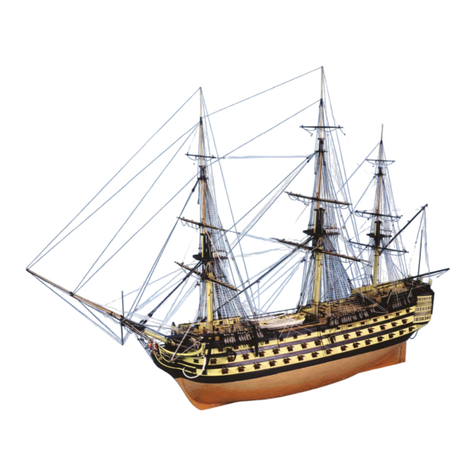
©2006 JoTiKa Ltd. 3
Before You Begin
PLEASE READ: A great deal of time has gone into the production this manual to try to make the build process as clear and
straightforward as possible. It is important that you should read each stage of construction thoroughly before starting the
assembly. Many components can only be correctly fitted or positioned relative to other components and as such you may need
to reference previous or future stages of the build for this information as detailed within the instructions. We have also tried to
provide any required fundamental information as points of Note.
Before you start building this model a little forethought now will be well worth the time given to it throughout the building
process.
Although the majority of suggestions will be second nature to the more experienced modeller, this kit and others in the series,
can be built by the less experienced, given sufficient information.
The instructions and parts manual has been compiled to give as much information as practicable together with additional
diagrams, photos and a complete set of actual scale technical plans.
Wherever possible, we have tried to explain technical terms, in particular nautical terminology, but it pays to have a good
selection of reference books to hand. Any defined terms, to be found in the back of manual 2, are denoted with an asterisk like
thisuat their first usage within the manual.
At a scale of 1:64, the model has an overall size of 600mm (L) x 240mm (W) x 530mm (H) and you should consider this when
setting aside a work area for the build. You will also need regular access to both sides of the model, especially when rigging,
you will therefore need an area large enough to walk around the model or large enough to easily turn the model through 180
degrees without risking damage. Also ensure the cords for any power tools will not interfere with the model.
A 5mm ply stand is provided with the kit. This will primarily be used to support the hull during the build process. Ideally this
stand should be secured to an adequate baseboard. Upon completion, the model can be placed on a display stand of your
choice.
During the build it will be necessary to sand down large areas, after the first and second planking and at other stages, it is
therefore advisable to work in a well ventilated area and / or wear appropriate protection. The same applies when using paints,
stains, glues, fillers etc. Good lighting is also essential to the modelmaker.
The structural parts of the model are cut from high quality birch plywood, the remaining wood parts are cut from high quality
walnut ply and solid walnut sheet. It is advisable to leave all components in their sheets until actually required for fitting.
Take particular care when removing parts with a craft knife and ensure all parts are identified and marked with pencil before
removal. Lay the sheet from which you are going to cut the parts on a rigid flat cutting board for removal. Use a heavy-duty
craft knife with a good strong blade to cut through the tabs holding the parts in place, alternatively, when cutting brass or
copper parts, a good pair of stout scissors will suffice. It will also be an advantage to paint the brass etched fittings prior to
removal from the sheet; they can then be touched up again when in place.
Note: All metal components such as the brass etch, castings, cannons etc. should be primed with metal primer prior to
painting.
Before each stage of construction, study both the manual and the plans until you are confident in the task ahead.
The majority of the model will be painted during various stages of the build. It is important to think ahead to the next stage in
the construction process and paint the various parts at a convenient time, usually before securing on the model. It is often a
good idea to paint parts for the next stage and while they are drying you can be working on the current stage.
Wherever possible, offer the parts together in a ‘dry’ fit before final assembly.
Before Planking the Hull: A Note
In order that the final width of the planked hull will match the width of the stern post, some sanding will be required prior to
both first and second planking.
Before the first planking is applied as described on page 7:
1. Using Plan Sheet 1 for reference, mark the bearding lineuonto the keel.
2. Gently sand the shaded area, towards the sternu, until you have a taper that runs from 5mm wide at the bearding line
to 3mm wide at the stern.
3. Continue as instructed with the first planking and upon completion the width at the stern will be 5mm.
Before the second planking is applied as described on page 9:
1. Note the bearding line onto the first planking, again using Plan Sheet 1 for reference.
2. Gently sand the shaded area, towards the stern, until you have a taper from the bearding line to 3mm wide at the stern.
3. Continue as instructed with the second planking and upon completion the width at the stern will again be 5mm.






























